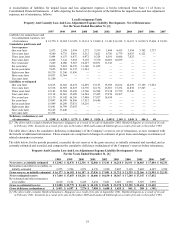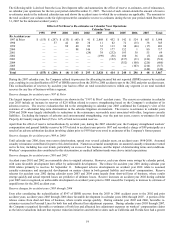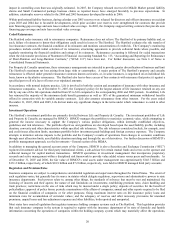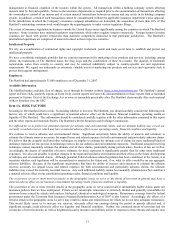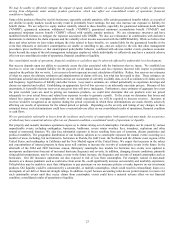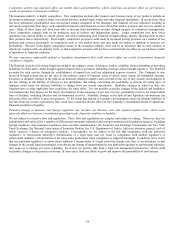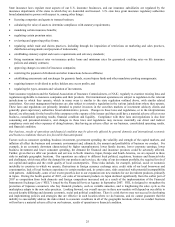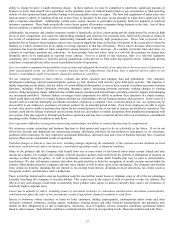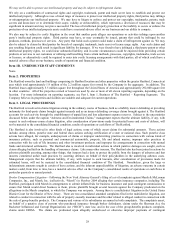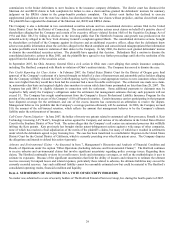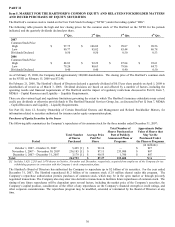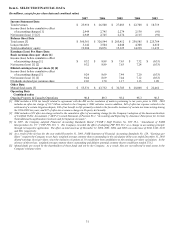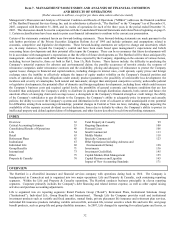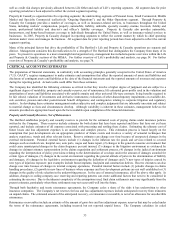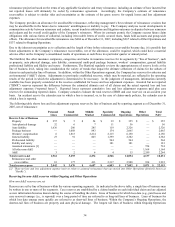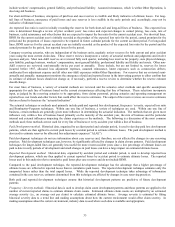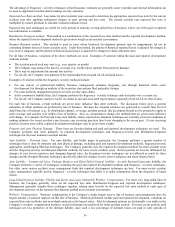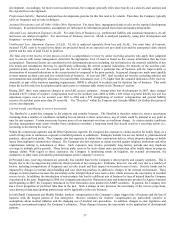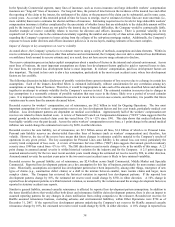The Hartford 2007 Annual Report Download - page 28
Download and view the complete annual report
Please find page 28 of the 2007 The Hartford annual report below. You can navigate through the pages in the report by either clicking on the pages listed below, or by using the keyword search tool below to find specific information within the annual report.28
We may not be able to protect our intellectual property and may be subject to infringement claims.
We rely on a combination of contractual rights and copyright, trademark, patent and trade secret laws to establish and protect our
intellectual property. Although we use a broad range of measures to protect our intellectual property rights, third parties may infringe
or misappropriate our intellectual property. We may have to litigate to enforce and protect our copyrights, trademarks, patents, trade
secrets and know-how or to determine their scope, validity or enforceability, which represents a diversion of resources that may be
significant in amount and may not prove successful. The loss of intellectual property protection or the inability to secure or enforce the
protection of our intellectual property assets could have a material adverse effect on our business and our ability to compete.
We also may be subject to costly litigation in the event that another party alleges our operations or activities infringe upon another
party’ s intellectual property rights. Third parties may have, or may eventually be issued, patents that could be infringed by our
products, methods, processes or services. Any party that holds such a patent could make a claim of infringement against us. We may
also be subject to claims by third parties for breach of copyright, trademark, trade secret or license usage rights. Any such claims and
any resulting litigation could result in significant liability for damages. If we were found to have infringed a third-party patent or other
intellectual property rights, we could incur substantial liability, and in some circumstances could be enjoined from providing certain
products or services to our customers or utilizing and benefiting from certain methods, processes, copyrights, trademarks, trade secrets
or licenses, or alternatively could be required to enter into costly licensing arrangements with third parties, all of which could have a
material adverse effect on our business, results of operations and financial condition.
Item 1B. UNRESOLVED STAFF COMMENTS
None.
Item 2. PROPERTIES
The Hartford owns the land and buildings comprising its Hartford location and other properties within the greater Hartford, Connecticut
area which total approximately 1.9 million of the 2.2 million square feet owned by the Company in the aggregate. In addition, The
Hartford leases approximately 5.5 million square feet throughout the United States of America and approximately 292,000 square feet
in other countries. All of the properties owned or leased are used by one or more of all eleven reporting segments, depending on the
location. For more information on reporting segments, see Part I, Item 1, Business of The Hartford – Reporting Segments. The
Company believes its properties and facilities are suitable and adequate for current operations.
Item 3. LEGAL PROCEEDINGS
The Hartford is involved in claims litigation arising in the ordinary course of business, both as a liability insurer defending or providing
indemnity for third-party claims brought against insureds and as an insurer defending coverage claims brought against it. The Hartford
accounts for such activity through the establishment of unpaid loss and loss adjustment expense reserves. Subject to the uncertainties
discussed below under the caption “Asbestos and Environmental Claims,” management expects that the ultimate liability, if any, with
respect to such ordinary-course claims litigation, after consideration of provisions made for potential losses and costs of defense, will
not be material to the consolidated financial condition, results of operations or cash flows of The Hartford.
The Hartford is also involved in other kinds of legal actions, some of which assert claims for substantial amounts. These actions
include, among others, putative state and federal class actions seeking certification of a state or national class. Such putative class
actions have alleged, for example, underpayment of claims or improper underwriting practices in connection with various kinds of
insurance policies, such as personal and commercial automobile, property, life and inland marine; improper sales practices in
connection with the sale of life insurance and other investment products; and improper fee arrangements in connection with mutual
funds and structured settlements. The Hartford also is involved in individual actions in which punitive damages are sought, such as
claims alleging bad faith in the handling of insurance claims. Like many other insurers, The Hartford also has been joined in actions by
asbestos plaintiffs asserting, among other things, that insurers had a duty to protect the public from the dangers of asbestos and that
insurers committed unfair trade practices by asserting defenses on behalf of their policyholders in the underlying asbestos cases.
Management expects that the ultimate liability, if any, with respect to such lawsuits, after consideration of provisions made for
estimated losses, will not be material to the consolidated financial condition of The Hartford. Nonetheless, given the large or
indeterminate amounts sought in certain of these actions, and the inherent unpredictability of litigation, an adverse outcome in certain
matters could, from time to time, have a material adverse effect on the Company’s consolidated results of operations or cash flows in
particular quarterly or annual periods.
Broker Compensation Litigation – Following the New York Attorney General’ s filing of a civil complaint against Marsh & McLennan
Companies, Inc., and Marsh, Inc. (collectively, “Marsh”) in October 2004 alleging that certain insurance companies, including The
Hartford, participated with Marsh in arrangements to submit inflated bids for business insurance and paid contingent commissions to
ensure that Marsh would direct business to them, private plaintiffs brought several lawsuits against the Company predicated on the
allegations in the Marsh complaint, to which the Company was not party. Among these is a multidistrict litigation in the United States
District Court for the District of New Jersey. There are two consolidated amended complaints filed in the multidistrict litigation, one
related to conduct in connection with the sale of property-casualty insurance and the other related to alleged conduct in connection with
the sale of group benefits products. The Company and various of its subsidiaries are named in both complaints. The complaints assert,
on behalf of a putative class of persons who purchased insurance through broker defendants, claims under the Sherman Act, the
Racketeer Influenced and Corrupt Organizations Act (“RICO”), state law, and in the case of the group-benefits products complaint,
claims under ERISA. The claims are predicated upon allegedly undisclosed or otherwise improper payments of contingent


